Uffizi
|
Narrow courtyard between palace's two wings with view toward the Arno. | |
| Established | 1581 |
|---|---|
| Location |
Piazzale degli Uffizi, 50122 Florence, Italy |
| Type | Art museum, Design/Textile Museum, Historic site |
| Visitors |
1.9 million (2013)[1] Ranked 25th globally (2013)[1] |
| Website | Uffizi |

The Uffizi Gallery (Italian: Galleria degli Uffizi, pronounced [ɡalleˈriːa deʎʎ ufˈfittsi]) is a prominent art museum located adjacent to the Piazza della Signoria in central Florence, region of Tuscany, Italy.
History
The building of Uffizi complex was begun by Giorgio Vasari in 1560 for Cosimo I de' Medici so as to accommodate the offices of the Florentine magistrates, hence the name uffizi, "offices". The construction was later continued by Alfonso Parigi and Bernardo Buontalenti and completed in 1581. The cortile (internal courtyard) is so long and narrow, and open to the Arno at its far end through a Doric screen that articulates the space without blocking it, that architectural historians[2] treat it as the first regularized streetscape of Europe. Vasari, a painter and architect as well, emphasised its perspective length by the matching facades' continuous roof cornices, and unbroken cornices between storeys and the three continuous steps on which the palace-fronts stand. The niches in the piers that alternate with columns filled with sculptures of famous artists in the XIX century.
The Uffizi brought together under one roof the administrative offices, the Tribunal and the Archivio di Stato, the state archive. The project commissioned by Cosimo I de' Medici, Grand Duke of Tuscany planned to display prime art works of the Medici collections on the piano nobile; the plan was carried out by his son, Grand Duke Francesco I. He commissioned from the architect Buontalenti the design of the Tribuna degli Uffizi that collected a series of masterpieces in one room, and was a highly influential attraction of a Grand Tour.
Over the years, more sections of the palace were recruited to exhibit paintings and sculpture collected or commissioned by the Medici. According to Vasari, who was not only the architect of the Uffizi but also the author of Lives of the Artists, published in 1550 and 1568, artists such as Leonardo da Vinci and Michelangelo gathered at the Uffizi "for beauty, for work and for recreation."[3]
After the house of Medici was extinguished, the art treasures remained in Florence by terms of the famous Patto di famiglia negotiated by Anna Maria Luisa, the last Medici heiress; it formed one of the first modern museums. The gallery had been open to visitors by request since the sixteenth century, and in 1765 it was officially opened to the public.
Because of its huge collection, some of its works have in the past been transferred to other museums in Florence—for example, some famous statues to the Bargello. A project is currently underway to expand the museum's exhibition space in 2006 from some 6,000 metres² (64,000 ft²) to almost 13,000 metres² (139,000 ft²), allowing public viewing of many artworks that have usually been in storage.
On 27 May 1993, a car bomb exploded in Via dei Georgofili and damaged parts of the palace, killing five people. The most severe damage was to the Niobe room and classical sculptures and neoclassical interior of which have been restored, although its frescoes were damaged beyond repair. The identity of the bomber or bombers are unknown, although it was almost certainly attributable to the Sicilian Mafia who were engaged in a period of terrorism at that time.
Today, the Uffizi is one of the most popular tourist attractions of Florence. In high season (particularly in July), waiting times can be up to five hours.
In early August 2007, Florence was caught with a large rainstorm, and the Gallery was partially flooded, with water leaking through the ceiling, and the visitors had to be evacuated. There was a much more significant flood in 1966 which damaged most of the art collections in Florence severely, including the Uffizi.
Here is a selection from the painting collection:
- Cimabue: Santa Trinita Maestà
- Duccio: Rucellai Madonna
- Giotto: Ognissanti Madonna, Badia Polyptych
- Simone Martini: Annunciation with St. Margaret and St. Ansanus
- Ambrogio Lorenzetti: Presentation at the Temple
- Gentile da Fabriano, Adoration of the Magi
- Paolo Uccello: The Battle of San Romano
- Rogier van der Weyden, Lamentation of Christ
- Fra Filippo Lippi: Madonna and Child, Coronation of the Virgin
- Piero della Francesca: Diptych of Duke Federico da Montefeltro and Duchess Battista Sforza of Urbino
- Andrea del Verrocchio: The Baptism of Christ
- Hugo van der Goes: Portinari Triptych
- Sandro Botticelli: Primavera, The Birth of Venus, Adoration of the Magi of 1475 and others
- Leonardo da Vinci: The Annunciation, Adoration of the Magi
- Piero di Cosimo: Perseus Freeing Andromeda
- Albrecht Dürer: Adoration of the Magi
- Michelangelo: Doni Tondo
- Raphael: Madonna of the Goldfinch, Portrait of Leo X
- Titian: Flora, Venus of Urbino
- Parmigianino: Madonna with the Long Neck
- Caravaggio: Bacchus, Sacrifice of Isaac, Medusa
- Artemisia Gentileschi: Judith and Holofernes
- Rembrandt: Self-portrait as a Young Man, Self-portrait as an Old Man, Portrait of an Old Man
The collection also contains some ancient sculptures, such as the Arrotino and the Two Wrestlers.
Selected highlights
-
_Photo_Paolo_Villa_FOTO9235bisimg_0001.jpg)
Tribuna
-

Simone Martini
Annunciation, 305 × 265 cm -
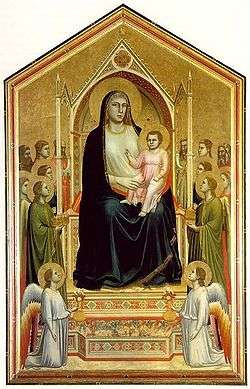
Giotto di Bondone
Ognissanti Madonna, 325 × 204 cm. -
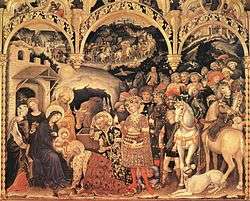
Gentile da Fabriano
Adoration of the Magi, 300 × 282 cm. -

Fra Angelico
Coronation of the Virgin, 112 × 114 cm -

Masaccio
The Madonna and St. Anna, 175 × 103 cm. -

Lorenzo Monaco
Adoration of the Magi, 115 × 177 cm. -
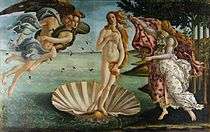
Sandro Botticelli
Birth of Venus, 173 × 279 cm. -

Sandro Botticelli
La Primavera, 203 × 314 cm. -
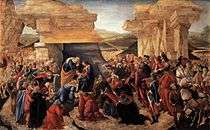
Sandro Botticelli
Adoration of the Magi, 108 × 173 cm. -

Sandro Botticelli
Adoration of the Magi, 111 × 134 cm. -

Piero della Francesca
Dukes of Urbino, 47 × 66 cm. -

Filippo Lippi
Madonna and Child with Angel, 95 × 64 cm. -

Leonardo da Vinci
Adoration of the Magi, 243 × 246 cm. -

Leonardo da Vinci
Annunciation, 98 × 217 cm. -

Verrocchio & Leonardo da Vinci
Baptism of Christ, 177 × 151 cm. -
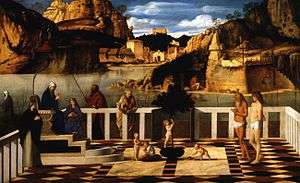
Giovanni Bellini
Sacred Allegory, 73 × 119 cm. -

Piero di Cosimo
Perseus Freeing Andromeda, 70 × 123 cm -
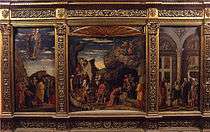
Andrea Mantegna
Adoration of the Magi, 86 × 162 cm. -

Parmigianino
Madonna of Long Neck, 216 × 132 cm. -
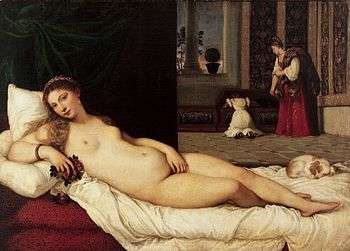
Titian
Venus of Urbino, 119 × 165 cm. -

Titian
Flora, 80 × 64 cm. -

Raphael
Madonna of the Goldfinch, 107 × 77 cm. -

Michelangelo
Doni Tondo, Diameter 120 cm. -
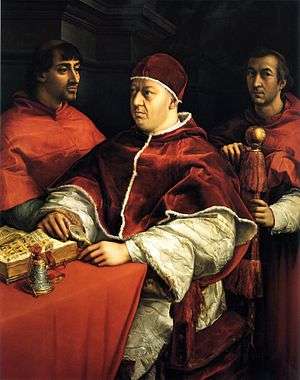
Raphael
Pope Leo X and Family, 154 × 119 cm. -

Giorgione
Judgement of Solomon, 89 × 72 cm. -

Paolo Uccello
Battle of San Romano, 182 × 220 cm. -

Giorgione
Moses Trial, 89 × 72 cm. -
.jpg)
Caravaggio
Sacrifice of Isaac, 104 × 135 cm -

Caravaggio
Medusa, Diameter 55 cm. -

Correggio
Rest on Flight to Egypt, 124 × 107 cm. -

Rogier van der Weyden
Lamentation of Christ, 96 × 110 cm. -

Albrecht Dürer
Adoration of the Magi, 99 × 114 cm. -

Hans Memling
Madonna and Angels, 76 x60 cm. -

Francisco Goya
Portrait of María Teresa, 83 × 62 cm. -

Pieter Paul Rubens
Triumph of Henry IV in Paris, 380 × 692 cm. -

Diego Velázquez
Self Portrait, 104 × 83 cm. -
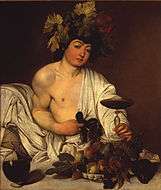
Caravaggio
Young Bacchus, 95 × 85 cm. -

Agnolo Bronzino
Portrait of Eleanor of Toledo, 115 × 96 cm. -

Rembrandt
Portrait of Johan Comenius, 104 × 86 cm. -

Rembrandt
Self-Portrait, 74 × 55 cm. -
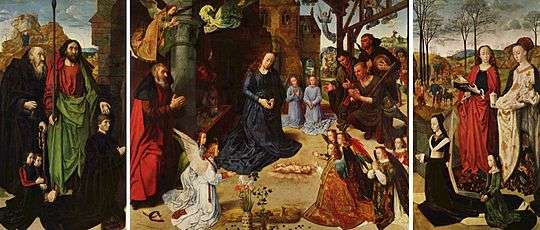
Hugo van der Goes
Portinari Triptych, 253 × 304 cm. -
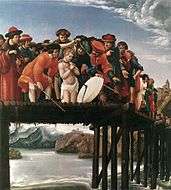
Albrecht Altdorfer
Martyrdom of St Florian, 76 × 67 cm. -

Anthony van Dyck
Portrait of Charles V, 191 × 123 cm. -

Paolo Veronese
Martyrdom of Saint Justina, 103 × 113 cm. -

El Greco
St. John and St. Francis, 110 × 86 cm.
See also
- Collections of the Uffizi
Notes
- 1 2 Top 100 Art Museum Attendance, The Art Newspaper, 2014, p. 15. Retrieved on 25 July 2014.
- ↑ Sigfried Giedion, Space, Time and Architecture (1941) 1962 fig.17.
- ↑ Fossi, Gloria. The Uffizi. (Giuniti, 1999), p. 8.
External links
| Wikimedia Commons has media related to Uffizi, |
- Official website
- Museum expansion project official website – The New Uffizi
- Uffizi – Google Art Project
Coordinates: 43°46′07″N 11°15′19″E / 43.768639°N 11.255214°E
|
